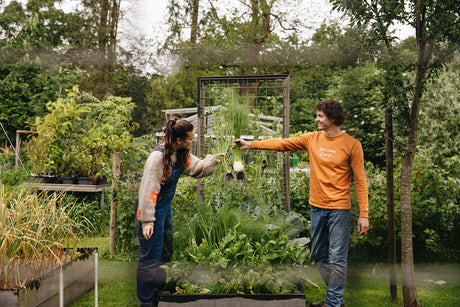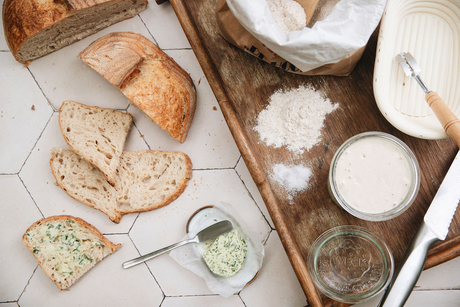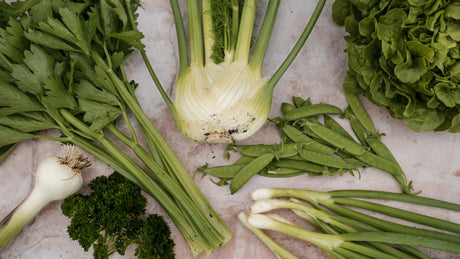Everyone has seen them, the enormous
pumpkin that vegetable gardeners show off. These boys or girls do not do it for a hearty meal like most of us grow vegetables or fruit in our vegetable garden. They do it for the sport, the excitement of the weighing, the art of pushing a plant to its limits, ... and so much more. Member of our
Facebook group Moestuin Dries Van der Vennet explains how to go about it.
Supplies:
- A good seed
- Large piece of land
- Nutrient-rich soil
- Time
- Happiness
The seed
Growing a giant
pumpkin starts with selecting a good seed. The
seeds available here in the Moestuinweetjes webshop contain the genetics to produce a 200kg
pumpkin without too much effort. However, if you put in more time and effort, weights of 500kg and more are certainly achievable!

The elite
seeds each get their own name, such as:
- 1015VanderVennet12
- 1015 = weight in pounds = approx. 460kg
- VanderVennet = surname of the breeder
- 12 = year in which the pumpkin was grown
The cross of the 1015Vandervennet12 is 1674Marsh10 x 1544Revier09. This means that the grower has grown a
pumpkin of 460 kg from a seed of a
pumpkin of 759 kg, which was pollinated by a male flower that came from a plant from a seed of a
pumpkin that weighed 700 kg.
It may seem complicated, but one thing is for sure! The
seeds available here are a very good start to success!
The ground
pumpkin and like a nutritious and airy soil. So you certainly won't do any harm by adding lots of
compost and old stable manure. Other organic fertilizers are also no problem, but be careful with synthetic fertilizers! In too much, these can burn the plant.

To grow a very large
pumpkin , you will need a large piece of land. An area between 45 and 80 square meters is not an unnecessary luxury! Of course, you can also grow a remarkable
pumpkin on a smaller piece of land.
Sowing

It is advisable to lightly (!!!) work the sides (NOT the point) of the seed with a nail file or fine sandpaper, so that it can burst open more easily later. It also helps to soak the seed in lukewarm water for a few hours before planting.
Use a fairly large pot and try to keep the
potting soil at room temperature. Ideally around 25°C. Plant the seed with the point down at a depth of 1-2cm.
Do not make the
potting soil too moist, otherwise there is a chance that the seed will rot. Once the plant is visible (4 to 14 days, depending on the circumstances), you can give it some more water.
Plant out
This depends on whether you are growing in a
greenhouse or outdoors. In a
greenhouse you can start from the second week of April. In the open air it depends on the weather, but it might be wise to plant out after
the Ice Saints .

When planting, put the stem completely in the ground. Only the cotyledons and the first true leaf may stick out above the ground. The plant almost always grows in the opposite direction of the first leaf. The first leaf is therefore the back of the plant.
Make sure the plant does not get too cold.
Plant growth
The first few weeks of growth are quite slow, but once the plant starts to vine, the work is almost impossible to keep up with.
When the vines are dug in or covered with soil, extra roots are created at the leaf axils. Extra roots mean extra nutrient uptake and this results in a bigger
pumpkin !

At each leaf axil the following appears: a root, a male or female flower, a tendril, a leaf and an attachment tendril. On the main tendril the tendrils are allowed to grow, these are the secondary (side) tendrils. But on these secondary tendrils a (tertiary) tendril appears again at each leaf axil, these must all be removed (as early as possible). Otherwise it becomes a wild growth and the plant can no longer be controlled.
Pollination
When the main vine has reached a length of 3 meters, one can consider keeping and pollinating a female fruit. The female flowers can be recognized by the bulb under the petals, which later develops into
a pumpkin .

It is advisable to keep 1 fruit on the main vine. This has a better sap flow from the main root, compared to a fruit on the side vine.
Only 1 fruit is kept per plant!
Position of the fruit
As the fruit begins to grow, the shoulders of the
pumpkin will begin to grow toward the vine and after a while will begin to pinch, tearing the fruit from the vine. Therefore, the vines should be bent away from the
pumpkin early, and in small increments at a time. Be careful not to break the stem or snap the vine!

Watering
To gain so many kilos, the plant obviously needs a lot of water! It is difficult to put a quantity on it, as this depends on the size of the plant and the climate. Make sure that the soil is constantly moist, but certainly not too wet!

GOOD LUCK!!
Dries
Back to top
 The elite seeds each get their own name, such as:
The elite seeds each get their own name, such as:
 To grow a very large pumpkin , you will need a large piece of land. An area between 45 and 80 square meters is not an unnecessary luxury! Of course, you can also grow a remarkable pumpkin on a smaller piece of land.
To grow a very large pumpkin , you will need a large piece of land. An area between 45 and 80 square meters is not an unnecessary luxury! Of course, you can also grow a remarkable pumpkin on a smaller piece of land.
 It is advisable to lightly (!!!) work the sides (NOT the point) of the seed with a nail file or fine sandpaper, so that it can burst open more easily later. It also helps to soak the seed in lukewarm water for a few hours before planting.
Use a fairly large pot and try to keep the potting soil at room temperature. Ideally around 25°C. Plant the seed with the point down at a depth of 1-2cm.
Do not make the potting soil too moist, otherwise there is a chance that the seed will rot. Once the plant is visible (4 to 14 days, depending on the circumstances), you can give it some more water.
It is advisable to lightly (!!!) work the sides (NOT the point) of the seed with a nail file or fine sandpaper, so that it can burst open more easily later. It also helps to soak the seed in lukewarm water for a few hours before planting.
Use a fairly large pot and try to keep the potting soil at room temperature. Ideally around 25°C. Plant the seed with the point down at a depth of 1-2cm.
Do not make the potting soil too moist, otherwise there is a chance that the seed will rot. Once the plant is visible (4 to 14 days, depending on the circumstances), you can give it some more water.
 When planting, put the stem completely in the ground. Only the cotyledons and the first true leaf may stick out above the ground. The plant almost always grows in the opposite direction of the first leaf. The first leaf is therefore the back of the plant.
Make sure the plant does not get too cold.
When planting, put the stem completely in the ground. Only the cotyledons and the first true leaf may stick out above the ground. The plant almost always grows in the opposite direction of the first leaf. The first leaf is therefore the back of the plant.
Make sure the plant does not get too cold.
 At each leaf axil the following appears: a root, a male or female flower, a tendril, a leaf and an attachment tendril. On the main tendril the tendrils are allowed to grow, these are the secondary (side) tendrils. But on these secondary tendrils a (tertiary) tendril appears again at each leaf axil, these must all be removed (as early as possible). Otherwise it becomes a wild growth and the plant can no longer be controlled.
At each leaf axil the following appears: a root, a male or female flower, a tendril, a leaf and an attachment tendril. On the main tendril the tendrils are allowed to grow, these are the secondary (side) tendrils. But on these secondary tendrils a (tertiary) tendril appears again at each leaf axil, these must all be removed (as early as possible). Otherwise it becomes a wild growth and the plant can no longer be controlled.
 It is advisable to keep 1 fruit on the main vine. This has a better sap flow from the main root, compared to a fruit on the side vine.
Only 1 fruit is kept per plant!
It is advisable to keep 1 fruit on the main vine. This has a better sap flow from the main root, compared to a fruit on the side vine.
Only 1 fruit is kept per plant!

 GOOD LUCK!!
Dries
Back to top
GOOD LUCK!!
Dries
Back to top







